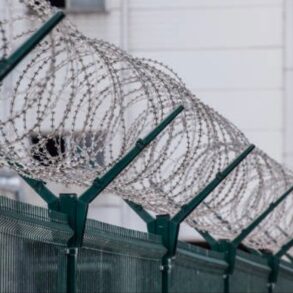The Trump administration appears to be considering a plan to send immigrants facing deportation to a recently shuttered federal prison so plagued by sexual abuse that it was known as the “rape club,” according to an email sent by federal prison union officials.
Roughly 20 miles east of Oakland, the Federal Correctional Institution in Dublin shut down last year, after more than a half-dozen correctional officers and the former warden were either charged with or convicted of sexually abusing female inmates.
Currently, the Federal Bureau of Prisons website shows there are no inmates held in the facility — though the long-term fate of the complex has never been clear.
But on Thursday, the American Federation of Government Employees Council of Prison Locals No. 33, which represents federal prison workers, sent an information request to the prison system, asking for data relating to facility closures. A few paragraphs into the four-page request, union leaders voiced concerns about the future of the facility.
“FCI Dublin had at least one assessment completed on July 22, 2024, which we believe was considered a ‘structural assessment,’” the letter said. “The union has learned that this assessment has been provided to ICE for what appears to be the potential of ICE taking over the facility.”
The move comes days after the Federal Bureau of Prisons confirmed that it is housing migrant detainees in some facilities, an admission that sparked concerns from union officials who say it appears the bureau is preparing to house migrants on a mass scale.
“My fear is that the bureau is just going to become a branch of ICE — but that’s not what we do,” John Kostelnik, the Western region vice president for the correctional workers union, told The Times. “Our primary focus should be and always has been keeping the community safe from convicted murderers and rapists and our staff do a tremendous job of that, even while dealing with the staffing crisis.
“But now we’re having an additional mission thrown at us,” he said, “that could cripple our ability to do what we’re supposed to do.”
Though the Bureau of Prisons confirmed in an email that it is “assisting the United States Immigration and Customs Enforcement by housing detainees,” prison spokespeople declined to provide information about the legal status of the detainees or where they will be housed.
One prisons spokesperson cited “safety and security reasons” for declining to comment, while another referred all immigration-related questions to ICE.
In an email Wednesday afternoon, ICE said its “enhanced enforcement operations” have netted enough arrests to “require greater detention capacity,” though the agency did not provide information on what that entailed.
“While we cannot confirm individual pre-decisional conversations,” the statement said, “we can confirm that ICE is exploring all options to meet its current and future detention requirements.”
In recent weeks, the Trump administration has begun ramping up immigration enforcement operations nationwide, pledging to deport “millions and millions” of people back to their home countries. According to the Associated Press, ICE has the budget to detain only about 41,000 people.
Typically, those detainees are held in ICE processing centers, private prison facilities, and local jails that contract with federal immigration officials. But with the new administration’s more ambitious deportation aims, officials have begun entertaining untried alternatives.
This month, the U.S. military began ferrying flights of detained migrants to the U.S. Navy base in Guantanamo Bay, Cuba, and El Salvador’s President Nayib Bukele has offered to let U.S. officials send migrants — as well as U.S. citizens — in his country’s notoriously harsh prisons.
The first signs the White House planned to hold detained migrants in U.S. federal prisons came late last month.
On Jan. 26, union leadership wrote to Sen. Alex Padilla’s office, warning the state’s senior senator that Trump officials had begun directing the Bureau of Prisons to make room for more inmates at facilities across the country.
“Currently the Trump administration has the BOP doing an audit of bedspace and asking facilities to consolidate inmates to make space (free up entire units),” the letter said.
The last time that happened, Kostelnik said, was during Trump’s first term. BOP officials were forced at that time to make space for 1,600 immigrants — including many asylum seekers — at federal prisons in Oregon, California, Arizona and Texas.
By August 2018 — two months after federal officials publicly confirmed the controversial housing scheme — the American Civil Liberties Union filed suit, alleging that it was a violation of the migrants’ due process rights under the 5th Amendment. By October, news reports indicated the administration had walked back its use of federal prisons to house migrant detainees.
According to Kostelnik, though, those few months proved chaotic for the detainees and prison staff, who were ill-equipped to safeguard migrants, many of whom had different medical needs and cultural backgrounds from the bureau’s typical prisoners. Communication sometimes became a challenge, as many detainees didn’t speak English, or any other language spoken by prison staff.
“I fear this is coming soon,” he wrote in the January email to Padilla’s office, “and all facilities in CA are currently moving on this request, and they are even getting our bus crews and specialized teams geared up for similar missions.”
The first federal prison in California to house detained migrants appears to have been the Metropolitan Detention Center in downtown Los Angeles. According to two officials familiar with the situation, Homeland Security Investigations showed up on a weekend with a group of about nine migrants from Africa. The officials requested anonymity because they were not authorized to speak publicly.
Initially, prison staff were unsure whether to accept the detainees, or how to best keep them separate from other prisoners. Eventually they put the men in their own unit within the facility, creating added work for the staff, who one official said had “no guidance” on how to handle migrants differently from typical federal prisoners.
The official also said that, although the number of migrants housed in the L.A. lockup has not increased, he expected it would because higher-ups had begun discussing how to adjust staffing schedules to handle more weekend intakes.
It’s not clear how many other facilities have been tasked with holding migrants, but last week the Associated Press reported that a federal jail in Miami and a federal prison in Atlanta are also being used for that purpose — and internal BOP emails show more facilities are likely to follow.
In recent days, federal prison officials have begun asking workers to consider taking temporary assignments elsewhere to help manage the influx of ICE detainees.
On Monday, a captain at FCI Sheridan — a medium-security facility in Oregon — emailed staff there to round up volunteers willing to work across the country at FCI Berlin, a medium-security facility in rural New Hampshire that the email said is expected to receive at least 500 migrants from ICE.
“Staff will be working Correctional Services posts in support of the BOP’s mission of temporarily housing the ICE detainees,” Capt. Joseph Cerone explained, according to a copy of the email obtained by The Times. “Given we anticipate 500+ detainees going to Berlin, in addition to custody help they will likely need assistance in Health Services and Psychology.”
The email did not specify when the immigrants are expected to arrive.
The influx of detainees could strain the already-understaffed federal prison system, which has long been plagued by violence and abuse — perhaps most notably at FCI Dublin, which was one of several facilities the bureau earmarked for closure or deactivation last year.
But it may not be the only one earmarked for use by ICE. On Wednesday, Kostelnik told The Times he’d just learned that immigration officials are scheduled to visit a federal facility in Morgantown — which was also targeted for closure — for an assessment much like the one at Dublin.
“To an already strained and stretched out staff,” Kostelnik told The Times, “seeing facilities they’ve worked at for so long being taken from them and handed to another agency is extremely demoralizing.”
More to Read
This post was originally published on this site be sure to check out more of their content.








